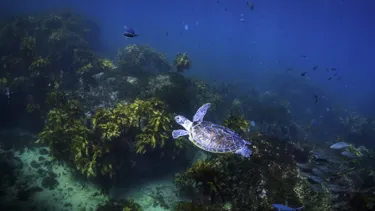Turtle Rehabilitation
- Monday 16th December 2024

Sea turtles didn't just survive the K-T extinction, they aced it. The turtles rode out the apocalyptic meteor strike that killed off the dinosaurs-and 90 percent of life on Earth-65 million years ago by doing what they've always done: taking things slowly.
Planet-pulverising asteroids they can deal with; plastic bags, however, might just be their undoing.
It seems a supermarket bag wafting in the current is, to a sea turtle, a dead ringer for a jellyfish, one of their favourite foods. Once inside, the bag impacts the digestive tract until the animal starves-unless it has the good fortune to end up in the care of Andrew Christie.
Tending to Sick and Injured Turtles
Curator of Kelly Tarlton's, Christie tends an increasing number of sick and injured turtles. Some are full of plastic bags, fishing lines and other flotsam, while others have been run over by boats or snagged on fish hooks.
Others arrive exhausted, diseased, dehydrated, shocked by New Zealand winter waters, or
otherwise 'compromised'. They can take months to recover; some have taken two years. They need blood tests, antibiotics and intravenous drips, incubators, and specialised food. "When we get them, they're pretty damn sick,"says Christie.
Once, he might have tended six injured turtles a year, but last year he had 21 patients, including greens, a hawksbill and an olive ridley turtle found at Houhora in the Far North. "As waters warm," he says, "and the ocean becomes a less healthy environment, we get more and more." So far this year, 12 turtles have ended up at Kelly Tarlton's and Andrew has helped nurse each and every one.
This is especially important because it may surprise you to learn that turtles are an integral part of the ocean ecosystem and play an important role in maintaining balance in our oceans.
Did you know SEA LIFE Kelly Tarlton’s Turtle Conservation is the only place in New Zealand that rehabilitates rescued turtles? That’s right! Calling all turtle lovers (or nature lovers) of every age! Discover how we work with these amazing creatures at our Turtle Bay in Auckland. Here’s everything you need to know about this adventure.
Turtle Decline
There are seven marine turtle species, five of which are found in New Zealand waters. These majestic shelled creatures live in warmer tropical waters, but many wash up in colder areas if they’re weak from illnesses like dehydration, cold shock, and starvation. They also suffer from ailments such as missing limbs, large wounds, bacterial infections, fish hooks, or plastic pollution ingestion. Sadly, this ancient species is now endangered, nearly on the verge of extinction.
To The Rescue!
For more than 20 years, we’ve been supporting our precious turtle population, together with the Department of Conservation and contracted vets from the Auckland Zoo. This involves providing x-rays, fluids for rehydration, and antibiotics to fight infections for these shelled species. Then at SEA LIFE Kelly Tarlton’s, we figure out why the poor turtles are sick before we treat and monitor them in quarantine.
Check out our page dedicated to our turtle release program and see some of the many turtles we have rescued, rehabilitated and released.
Hang in There
And don’t worry, we don’t go cold-turtle on them afterwards. We provide recovering turtles with a temporary home for anywhere from a few months to three years; until we think they’re ready to tackle the big wide ocean on their own again. During this time, they usually hang out in our larger fish or stingray tanks, where they’ve been known to chase our divers around for food!
When the weather’s warm enough for release, we tag the turtle’s flippers or have them satellite tagged on their shells so we can stay in touch. Because that’s what friends do right? (well that, and to learn more about their habits and migration). Then, it’s back where you belong, little guy. To this day, we’ve helped over 50 sick Green, Hawksbill, Olive Ridley, and Loggerhead turtles return to the wild as healthy, happy animals.
Join Us
Unfortunately, a few paragraphs can’t accurately paint the real picture. That’s why we use state-of-the-art technology to create an interactive virtual experience so you can get a sense of what it’s like to be a turtle-care expert. At Turtle Bay – embark on the full-circle journey of rescuing a turtle; from when you receive an emergency rescue alert to the memorable moment you part ways. Of course, you can come and say hi to the real-life turtles that are part of our rescue program too.
We also show you how humans have a huge impact on local marine life without us even realising it. By experiencing all the hard work carried out by our turt-ally talented team at the rehabilitation centre, you’ll leave Turtle Bay feeling more inspired to care for our marine environment.
(Psst! Secret bonus: head over to our cafe to get unique, prime views of the Hauraki Gulf.)
